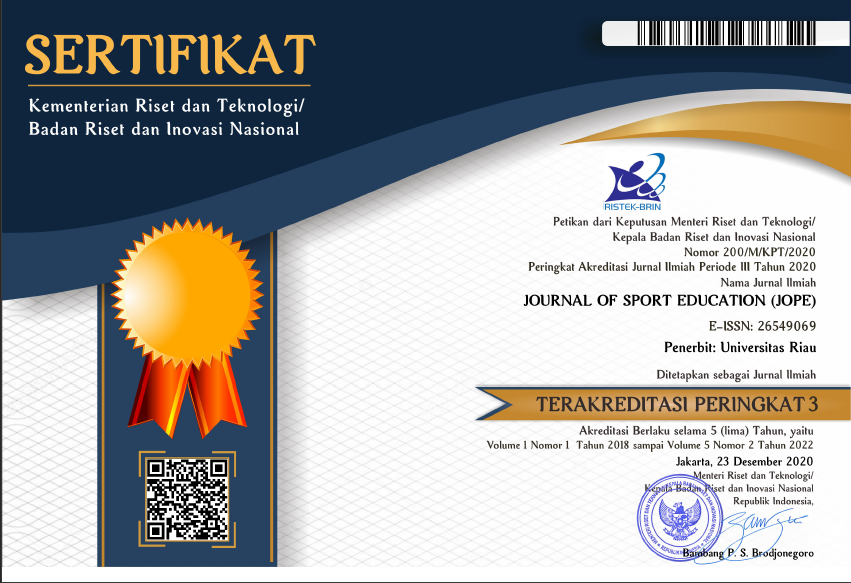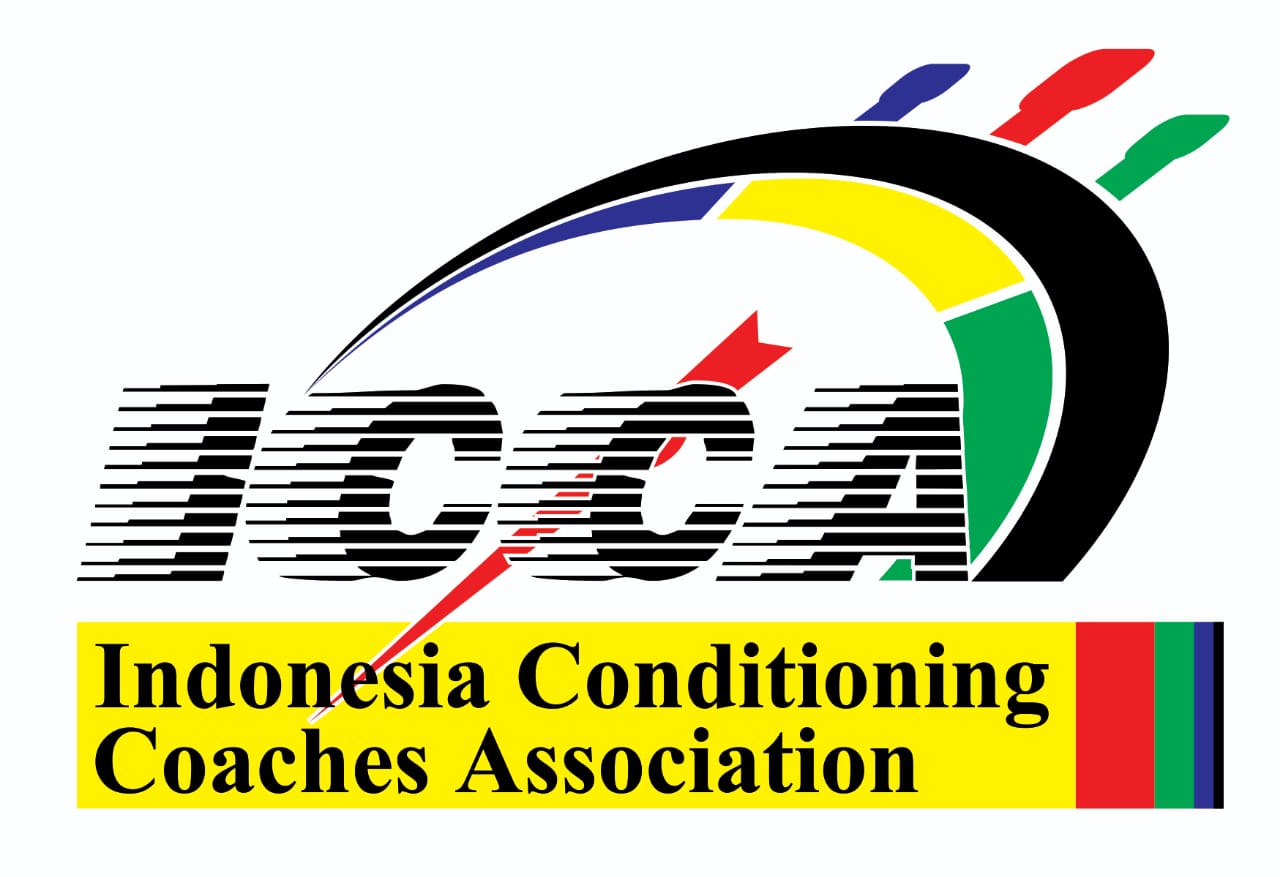Implementation of fundamental movement learning gymnastics in elementary schools
Abstract
(English)
This research aims to study how students learn basic floor exercise movements in elementary school and the impact on physical and cognitive growth. The results of this research will provide guidelines for learning gymnastics in elementary schools and increase awareness of the importance of fun and interactive learning methods. The research method used in this action research is the Kemmis and McTaggart model. The research subjects were students from the second grade of elementary school aged between 8-9 years and totaling 27 children, consisting of 17 girls and 12 boys. The research instrument was an observation sheet related to students' responses during learning and basic gymnastics movement skills. The balance indicator obtained the highest average score, namely 84, twisting movement 79, rolling movement 72, and flexibility 75. From the results of the assessment, the average met the minimum criteria for student completeness in physical education learning. Meanwhile, the difference in assessments from cycle I and cycle II obtained a result of 2.868 which was greater than t0 2.755 and α (0.05). This research confirms that the implementation of basic gymnastics movements in elementary school students is effective in improving balance, coordination, and flexibility. It has a positive impact on student's physical development and should be integrated into the primary school sports curriculum. Research also confirms the important role of physical health in preparing children physically.
(Indonesian)
Tujuan penelitian ini untuk mempelajari bagaimana siswa belajar gerak dasar gymnasticdi sekolah dasar dan dampak pada pertumbuhan fisik dan kognitif. Hasil penelitian ini akan memberikan pedoman pembelajaran senam di sekolah dasar dan meningkatkan kesadaran akan pentingnya metode pembelajaran yang menyenangkan dan interaktif. Metode penelitian yang digunakan dalam penelitian tindakan ini adalah model Kemmis dan Mc Taggart. Subyek penelitian adalah siswa dari kelas dua SD yang berusia antara 8-9 tahun dan berjumlah 27 anak, terdiri dari 17 perempuan dan 12 laki-laki. Pengambilan sampel dengan purposive sampling yaitu menetapkan usia pada level 1 gymnastic. Instrumen penelitian berupa lembar observasi yang terkait dengan respon siswa selama pembelajaran dan tes keterampilan gerak dasar senam. Pada indicator keseimbangan memperoleh nilai rata-rata paling tinggi yaitu 84, gerakan memutar 79, gerakan berguling 72 dan kelenturan 75. Dari hasil penilaian tersebut rata-rata sudah memenuhi kriteria ketuntasan minimum siswa dalam pembelajran pendidikan jasmani. Sedangkan perbedaan penilaian dari siklus I dan siklus II diperoleh hasil 2,868 lebih besar dari t0 2,755 dan α (0,05). Penelitian ini mengkonfirmasi bahwa implementasi gerak dasar gymnastic pada siswa sekolah dasar efektif dalam meningkatkan keseimbangan, koordinasi, dan fleksibilitas. Ini memiliki dampak positif pada perkembangan fisik siswa dan sebaiknya diintegrasikan dalam kurikulum olahraga sekolah dasar. Penelitian juga mengkonfirmasi peran penting kesehatan fisik atau untuk mempersiapkan fisik bagi anak-anak.
Copyright © The Author (s) 2024

Keywords
References
Mismar, B. A, & Ikhweileh, S.M. (2020). The Impact of Training Program Associated with Musical Rhythm to Teach Female Student’s Gymnastics Selected Skills. International Journal of Applied Science and Technology, 10(4), 59-69. https://doi.org/10.30845/ijast.v10n4p5
Ávalos Ramos, M. A., Martínez Ruiz, M. A., & Merma-Molina, G. (2019). Implementation and evaluation of a collaborative gymnastic strategy. Revista Internacional de Medicina y Ciencias de La Actividad Fisica y Del Deporte, 19(76), 579–598. https://doi.org/10.15366/rimcafd2019.76.001
Čičirkaitė, F. (2022). Do 5-6-Year-Old Girls Who Attend Gymnastics Achieve Better Motor Skills’ Assessment Results Compared to those Who Do Not Attend Gymnastics. Reabilitacijos Mokslai: Slauga, Kineziterapija, Ergoterapija, 2(27), 68–74. https://doi.org/10.33607/rmske.v2i27.1263
Deineko, A., Lutsenko, L., & Petrov, D. (2021). Basic gymnastics as an effective means of enriching the motor experience of young athletes. Scientific Journal of National Pedagogical Dragomanov University. Series 15. Scientific and Pedagogical Problems of Physical Culture (Physical Culture and Sports), 4(134), 39–42. https://doi.org/10.31392/npu-nc.series15.2021.4(134).10
Demirel, N. (2018). The Impact of Therapeutic Recreational Gymnastic Exercise on Basic Motor Skills of Hearing-Impaired Children Aged Between 6 and 9 Years. Journal of Education and Training Studies, 6(3), 147. https://doi.org/10.11114/jets.v6i3.3048
Deyneko, A. (2015). Basic gymnastics as a basic component invariant component of the curriculum subject «Physical culture». Слобожанський Науково-Спортивний Вісник, 47(3), 30–34. https://doi.org/10.15391/snsv.2015-3.005
Bushra Kadhum, D. A. (2020). The effect of special exercises on improving general motor impairment to perform forward anterior heart rate skill on the mat of ground movements for ages (10-13). Modern Sport, 19(3), 01-18. https://doi.org/10.54702/msj.2020.19.3.0018
Fallah, E., Nourbakhsh, P., & Bagherly, J. (2015). The Effect of Eight Weeks of Gymnastics Exercises on the Development of Gross Motor Skills of Five to Six Years Old Girls. European Online Journal of Natural and Social Sciences Special Issue on New Dimensions in Economics, 4(1), 845–852. https://doi.org/10.33222/juara.v7i3.2440
Hassmannová, K., Pavlů, D., & Nováková, T. (2019). Most common injuries of the musculoskeletal system among children of elementary school age who engage in gymnastic sports (aerobics, artistic or rhythmic gymnastics) at an elite level. Auc Kinanthropologica, 55(1), 10–20. https://doi.org/10.14712/23366052.2019.2
Hidi, J. (2014). Gymnastics Program Involving Gym-ball Exercises Meant to Prevent Heart Diseases. Procedia - Social and Behavioral Sciences, 84 (4), 193–196. https://doi.org/10.1016/j.sbspro.2014.02.200
Huber, J. J. (2017). Applying Educational Psychology In Coaching Athletes. Sports Coaching Review, 9(1), 119–121. https://doi.org/10.1080/21640629.2019.1694807
Jusuf, J.B.K., Raharja, A.T., & Mahardika, N. A. (2019). The Development of Ritmic Gymnastic Model To Improve Basic Movement and Interest in Rytmic Gymnastic. Acitya Journal of Teaching & Education, 1(1), 1–37. https://journals.umkt.ac.id/index.php/acitya/article/view/205
Kaneko, Y., Hasegawa, C., & Mariko, Y. (2019). Research on the creation of an original school gymnastic to the university song and its benefits. Journal of Gymnastics for All, 7 (2), 31–38. https://doi.org/10.4107/gym.7.31
Karacsony, I., & Cuk, I. (2015). Floor Exercises: Methods, Ideas, Curiosities, History. Human Kinetics Publishers.
Kemmis, S., Mctaggart, R., & Zuber-Skerritt, O. (2002). The concept of action research. In The Learning Organization, 9 (3). 621-641. https://doi.org/10.1108/09696470210428840
Krištofič, J. (2018). Utilization of gymnastics in the dry preparation of hockey players. Studia Sportiva, 12(1), 31–37. https://doi.org/10.5817/sts2018-1-4
Kurniawan, A. W., & Hanief, Y. N. (2022). Development of basic movement learning models of the concept of play and games modification elementary school level. Journal Sport Area, 7(2), 246–261. https://doi.org/10.25299/sportarea.2022.vol7(2).8589
Kuzmina, S. V., & Anisimova, N. A. (2023). The state of implementation of the “Gymnastics” section of the physical education program for the of students of 1–11th grades. Physical Education and University Sport, 2(1), 63–69. https://doi.org/10.18500/2782-4594-2023-2-1-63-69
Lucas, W. C., Titus, S., & Young, M. E. M. (2019). Experiences of young South African gymnasts, parents and coaches about the health benefits of sport participation. African Journal for Physical Activity and Health Sciences (AJPHES), 25(2), 216–231. https://doi.org/10.4314/AJPHERD.V25I2
Salman. M. (2020). The effect suggested exercises to develop some motor abilities and learning some free skills in the rhythmic gymnastic of female students. University of Thi-Qar Journal of Medicine. 15 (1). 69-81. https://doi.org/10.32792/utq/utg/vol15/n.1/1
Miletić, M., Ilić, H. S., Jeremić, M., Parlić, M., Ilić, I., & Vidaković, H. M. (2019). The Effects of the Arthistic Gymnastics Program on Physical Fitness of Adolescents. Facta Universitatis, Series: Physical Education and Sport, 743-750. https://doi.org/10.22190/fupes190413034m
Ningrum, D. T. M., Chaniago, H., Pasaribu, A. M. N., & Mahyudi, Y. V. (2022). Types of Physical Activity and Sports for teens in Maintaining Physical Fitness in Leisure. Halaman Olahraga Nusantara (Jurnal Ilmu Keolahragaan), 5(2), 661-672. https://doi.org/10.31851/hon.v5i2.8710
Özer, Ö., & Soslu, R. (2019). Comparison of the Static Balance, Strength and Flexibility Characteristics of the University Students Who Taken Artistic Gymnastic Lesson. Turkish Journal of Sport and Exercise, 21 (2), 229–233. https://doi.org/10.15314/tsed.573516
Pasaribu, A. M. N., & Mashuri, H. (2019). The role of rhythmic gymnastics for physical fitness for elementary school students. Jurnal SPORTIF : Jurnal Penelitian Pembelajaran, 5(1), 89-98. https://doi.org/10.29407/js_unpgri.v5i1.12551
Paunović, M., Đurović, M., Veličković, S., Živković, M., & Stojanović, N. (2019).The Explosive Strength of Girls of the Younger School Age. Facta Universitatis, Series: Physical Education and Sport, 16(3). 677-685. https://doi.org/10.22190/fupes171022046p
Petrušič, T., Bogataj, Š., & Štemberger, V. (2022). Teaching Gymnastics Elements in Elementary School With Placebo Effect Digital Games: Cluster Randomised Controlled Trial. Kinesiologia Slovenica, 28(3), 5–15. https://doi.org/10.52165/kinsi.28.3.5-15
Polevoy, G. G. (2022). Development of Kinesthetic Differentiation of Movement Parameters of Children Aged 8-9 Years Using a Gymnastic Stick. Entomology and Applied Science Letters, 9(4), 65–70. https://doi.org/10.51847/zti27ovmot
Šimůnková, I., Novotná, V., & Vorálková, J. (2010). The structure of physical literacy for sport branch rhythmic gymnastics. Studia Kinanthropologica, 11(2), 110–117. https://doi.org/10.32725/sk.2010.029
Van Rossum, J. H. A. (2014). Life span motor development. In Human Movement Science (Vol. 6, Issue 1). https://doi.org/10.1016/0167-9457(87)90023-6
Yang, C. L., & Chen, C. H. (2018). Effectiveness of aerobic gymnastic exercise on stress, fatigue, and sleep quality during postpartum: A pilot randomized controlled trial. International Journal of Nursing Studies, 77, 1–7. https://doi.org/10.1016/j.ijnurstu.2017.09.009
DOI: http://dx.doi.org/10.31258/jope.6.2.115-125
Refbacks
- There are currently no refbacks.











